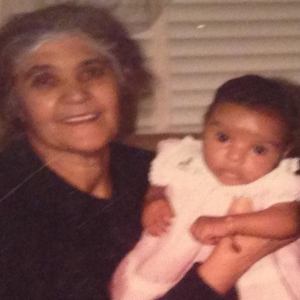A Griot is traditionally the holder of oral history. Generations of a family or community’s history is kept and retold by a Griot in the form of a song or a story. It is regarded as an art form that is passed down from generation to generation. To become a Griot is a process. One doesn’t decide to become one, they are born to be Griots. My great-grandmother embodied the role of Griot in every sense of the word. Through her, centuries-old medicinal remedies are still used for what ails us and generations of family history has not been forgotten. She was the bearer of family traditions and the role of teacher was one she took very seriously.
One of my earliest memories is of her crying/speaking, almost as if she was singing, upon the death of a family member. When she cried/spoke/sang, everyone seemed to quiet down as if to take in that person’s life story. It occurs to me now that, much in the way of traditional West African Griots, Bibi was the keeper of our community’s life story. At a person’s passing, she reminded us of who that person was in life as if to tell us to “never forget” through her Griot Song.
I listened to her Griot Song as a child as she recounted stories of her childhood or as she and my grandmother talked of news from “the Old Country”. I listened to her Griot Song as she shared wisdom with anyone who sought her advice for whatever was troubling them. I listened to her Griot Song as she prepared the ingredients for traditional meal such as Canja or (my favorite) Cachupa. I listened to her Griot Song almost every day for the 30 years I was honored to know her.
Through her Griot Song, my great-great grandparents, Rosa and Antonio, came to life as she spoke about the curls in her mother’s long hair or the gentle way her father spoke to her. I could see Ma Lina, her great grandmother, with the patch over her eye. I knew the worn paths from Cham de Sousa to Tome Barraz and I could hear the Mazurka, Valsa, and polka as people danced at a feast in Cova Rodella. I could hear the waves breaking over the beaches of Furna and Feijao d’Agu and hear the crickets singing while looking up at the ocean of stars on a clear night. Though her Griot Song, what could have been forever lost in the memory of our family, lives on.
In this tradition, I hope to continue her legacy not only of my own family history but for the ancestors of anyone who wishes to remember. The Griot’s Song is for the ancestors yet to be found and remembered, and to remind us of who we are and where we come from.

I can still hear her voice though it’s been 15 years since she took her last breath. Her words continue to guide me through my trials, her praises ring in my ears. Her gentle reminders of who I am and where I come from steady my foothold in this world. She was my compass, my foundation. My great-grandmother, Bibi, was the heart and soul of our family. She was Family Griot. As much as I miss her voice, her glare if you dared to do something she didn’t approve of, the melodic humming as she held me in her arms to help me fall asleep, I realize that she is with me everyday of my life. Her song, her Griot Song, continues……













